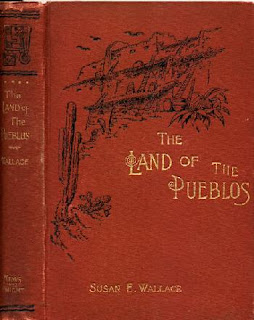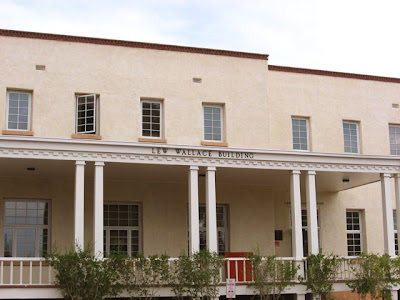 Lew Wallace may be best-known as the author of Ben-Hur, which he wrote in 1880 (and which has never been out of print since). But he was also Territorial Governor of New Mexico from 1878-1881, and he wrote the final chapters of his best-seller by candlelight in the Palace of the Governors on the Santa Fe Plaza.
Lew Wallace may be best-known as the author of Ben-Hur, which he wrote in 1880 (and which has never been out of print since). But he was also Territorial Governor of New Mexico from 1878-1881, and he wrote the final chapters of his best-seller by candlelight in the Palace of the Governors on the Santa Fe Plaza. Wallace was a 19-year-old law student in Indiana when the Mexican War broke out in 1846. He interrupted his studies to take a commission in General Zachary Taylor's army, though he saw little (if any) combat there. After the war he returned to Indiana and was admitted to the bar in 1849.
 After terms as a prosecutor and state senator, he was commissioned a colonel at the start of the Civil War, and had been promoted to major general by March, 1862. Due to what may have been communication problems, he was blamed by Grant for the loss at Shiloh. This loss, and the resulting damage to his reputation, haunted Wallace for the rest of his life. Some historians now feel that Ben-Hur told a thinly disguised story of Wallace's own life in that regard.
After terms as a prosecutor and state senator, he was commissioned a colonel at the start of the Civil War, and had been promoted to major general by March, 1862. Due to what may have been communication problems, he was blamed by Grant for the loss at Shiloh. This loss, and the resulting damage to his reputation, haunted Wallace for the rest of his life. Some historians now feel that Ben-Hur told a thinly disguised story of Wallace's own life in that regard.He was able to redeem himself somewhat by his delaying actions at the Battle of Monocacy, which held off Jubal Early's assault on Washington, DC long enough for the city to mount a defense.
His legal background and reputation for honesty landed him on the military commission that tried the Lincoln assassination conspirators, and he also helped to preside over the Andersonville court-martial. After the war he traveled to Texas and Northern Mexico to raise arms and money to help Benito Juarez in his attempt to win Mexican independence from Emperor Maximilian. His arrangements with Juarez forced him into deep debt, and he returned to Indiana to practice the law, write novels, and engage in an unsuccessful run for a Congressional seat.
During this period, Wallace was named to a committee responsible for counting disputed ballots in Florida after the 1876 presidential election. (Some things never change!)
In 1878, he was named Governor of the Territory of New Mexico. It is likely that the goal of sending Wallace to New Mexico was to clean up the corruption and lawlessness there. His predecessor, Governor Samuel Axtell, was accused of corruption and was involved with the infamous Santa Fe Ring. While Governor, Wallace apparently offered William Bonney (aka Billy the Kid) a pardon in return for testifying in the trial of men involved in the "Lincoln County War", but the Kid didn't uphold his end of the bargain.
 Later Bonney would try unsuccessfully to elicit Wallace's support, as shown in this letter from 1881 (six months before Bonney was shot to death by Sheriff Pat Garrett).
Later Bonney would try unsuccessfully to elicit Wallace's support, as shown in this letter from 1881 (six months before Bonney was shot to death by Sheriff Pat Garrett).While Governor, Wallace lived with his wife, Susan Arnold Elston Wallace, in the Palace of the Governors in Santa Fe, and was the first to realize the historic significance of that building (which is the oldest continually-occupied public building in the US). He lobbied for its renovation in Washington, DC, and while he wasn't able to effect any change during his tenure, he planted the seeds for future efforts.
He also realized the value of the historical documents stored there from the Spanish and Mexican governments (documents his wife had discovered in a dusty unused office in the Palace) and hired a Spanish-speaking archivist to start work on the monumental task of organizing these materials.
From 1881-1885, Wallace served as US Ambassador to the Ottoman Empire, after which he and Susan returned to Indiana where he wrote two more novels.
Wallace, a true Renaissance man, holds patents for eight inventions (including a fishing pole with a reel inside the handle and two kinds of pads to reduce vibration and noise from railroad tracks). He also played (and made) violins and painted large canvasses.
 His wife was also an author--she published six books, some of which were illustrated by Wallace. One of her most popular books was The Land of the Pueblos--her 19th century white woman's interpretation of life among the Spanish and Indian residents of the Southwest.
His wife was also an author--she published six books, some of which were illustrated by Wallace. One of her most popular books was The Land of the Pueblos--her 19th century white woman's interpretation of life among the Spanish and Indian residents of the Southwest.Wallace is memorialized in Santa Fe by the Lew Wallace Building. The building itself was built in 1887 as a dormitory for St. Michael's School, but was acquired by the state in the late 1960s, and now serves as offices for the State Engineer and the Department of Tourism.

For More Information
The website of the Lew Wallace Museum in Crawfordsville, Indiana has some nice informal photographs of Wallace, and articles about Wallace geared towards young readers.
More detailed information about Wallace's time in New Mexico can be found on the website of the Indiana Historical Society. There are lots of wonderful images in their digital library of Billy the Kid's letters to Wallace, along with other historical documents of the period.
No comments:
Post a Comment